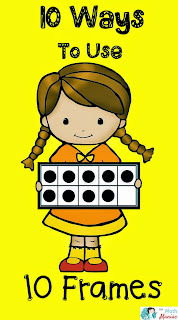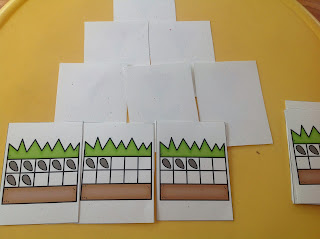Teaching kids to count to 100 is a big milestone and one that parents and teachers work on for a few years.
It's a long journey fraught with numbers like "fifteen-ten" and other assorted creative ways to count.
And along the way, kids are also learning to count by 2's, 5's, 10's and categorize numeric values.
For a number of years, I remember my kids coming home with a note asking that each child in the class bring in "100 of their favorite item" to celebrate the 100th day of school.
100 of their favorite item -- whew! Now those were some long discussions --
Kid: "How about 100 stuffed animals Mom?"
Me: How about we think of something a little smaller?
Kid: "I want to bring in something that the other kids won't bring."
Me: Ok, how about crayons?
Kid: No
Me: Tattoos?
Kid: No
And so it went for about 50 more suggestions until we finally came up with a winner!
And in the process, we also came up with quite a list of possibilities in case you're having trouble thinking of small items for your 100th Day of School.
100 Items to Use to Count to 100
There are some super fun ways to help kids practice all this counting. One popular idea is to introduce a 100's Jar. Similar to an estimation jar in many classrooms, a 100's Jar holds one-hundred pieces of the same item.
If you use plastic bottles or jars, you can introduce a number of math concepts such as volume, size and weight. So the first part of our list includes lots of items that can be counted, sorted, categorized and compared.
I had some extra canning jars that we used to do some counting and comparison. Just make sure that the jar or bottle you use it transparent so the kids can see & explore the items inside it. I've also tried to make life easier for you by including affiliate links to items that may not be well-known or might be hard to find.
Items to Count
Since items in this group are so similar, they are great to use for counting by 2's, 5's and 10's when they are sorted.
1. Paperclips
2. Pencils
3. Ping pong balls
5. Pennies (use with other coins to learn how to count money)
6. Nickels
7. Dimes
8. Quarters
9. Plastic spoons
11. Puzzle pieces (then put together the puzzle)
12. Game tokens
13. Rubber bands
Items to Categorize by Color
14. Guitar picks
15. Golf balls (they come in white, pink, yellow and orange)
16. Crayons
17. Playing cards (sort by color or suit)
18. Marbles (sort by shade/color)
19. Plastic eggs (sort by color or size)
22. Match box cars
24. Barbie shoes
25.
Glow Sticks 
(these are great to wear as bracelets too)
26. Mini erasers
27. Socks (just have each child bring in 4 mismatched socks)
28. Rubber bracelets or rings
Items to Sort & Measure for Height/Length
Grab a ruler and have the kids take measurements while they sort these items. You can also have them arrange each item from shortest to longest once they are measured.
29. Barettes (sort by color or length)
30. Bookmarks
31. Old keys
32. Golf tees
Sort by Type
There will be a variety of ways to sort the following items. Sort animals by habitat, continent, etc. Batteries can be sorted by type of size, stickers can be sorted by person/place/thing or have the kids come up with their own groupings.
33. Backpack clip toys or animals
34. Happy Meal toys
35. Tattoos
37. Plastic animal figurines (by animal)
38. Stickers
39. Postage stamps (by picture, face value, etc)
40. Cookie cutters
41. Trading cards
42. Shrinky dinks or charms
43. Batteries
44. Pieces from board games
Some of our nature items would also fit in this category such as rocks, seashells, pinecones and flowers. They are all listed below under natural materials.
Such a fun idea - compare popcorn both unpopped & popped!
Items that Teach Volume/Area
I love this type of item -- things that change the space they take up depending on how they are presented to the kids. These are pefect for a math/science discussion!
45. Paper or Plastic Cups (stacked one inside the other and stacked as a pyramid)
46. 100 millileters of a liquid (look at it in a cup and then pour it out on a cookie sheet or pie plate to discuss area)
47. Balloons (both blown up and flat)
48. Popcorn kernels (unpopped and popped)
Items to Craft with after you Count
So many fun craft projects can be done with these materials so have the kids count and then craft!
49. Buttons
50. Mini play dough containers
51. Pipe cleaners
52. Paint Brushes
53. Popsicle Sticks
55. Q-tips (then use them to paint)
56. Markers
58. Plastic beads (make a necklace)
59. Rainbow loom bands (make a bracelet)
61. Glue sticks
62. Cotton balls
If you use mini-marshmallows and toothpicks for your 100's jar, you can then pair them to create constellations for science exploration!
Items that Combine with Science & Engineering for Kids
Super items to use for counting and then experimenting!
63. Mentos (count and then use them to make volcanoes)
64. Toothpicks (combine with mini-marshmallows to make constellations)
65.
Sugar Cubes 
(yep, the still sell these at grocery stores and you can use them to build too!)
66. Legos (then race to see who can stack them the quickest)
67. Blocks (then see who can construct a bridge or the tallest building)
Have a stacking challenge with any of the next three iems --
68. Checkers
69. Poker chips
70. Dice
Food Items to use for 100 Days Snack
A very popular activity is creating a snack mix on the 100th Day so here's a few things the kids might want to eat together --
71. Pretzels
72. Marshmallows or mini-marshmallows
73. Fruit snack packets
74. Cereal
75. Dried pasta
76. Grains of rice (dry and cooked for science)
77. Jelly beans
78. Clementine oranges
79. Mini boxes of raisins
80. Hershey Kisses
81. Candy hearts
82. Grapes
83. Tea bags
84. Baby carrots
85. Cheese sticks
86. Goldfish crackers
87. Oyster crackers
88. Chocolate chips
89. Cookies
90. Tic tacs
91. Gumballs
92. Sticks of gum
93. Baby pickles
And don't forget the popcorn from above too!
Natural items to count, sort and explore
I would suggest having a Magnifying Glass handy with these items so the kids can explore them further.
handy with these items so the kids can explore them further.
94. Acorns
95. Pinecones
96. Leaves
97. Plant seeds
98. Rocks (use with shells to compare area)
99. Sea shells



.jpg)
.JPG)
.JPG)
.JPG)
.JPG)
.JPG)

.JPG)

.JPG)













